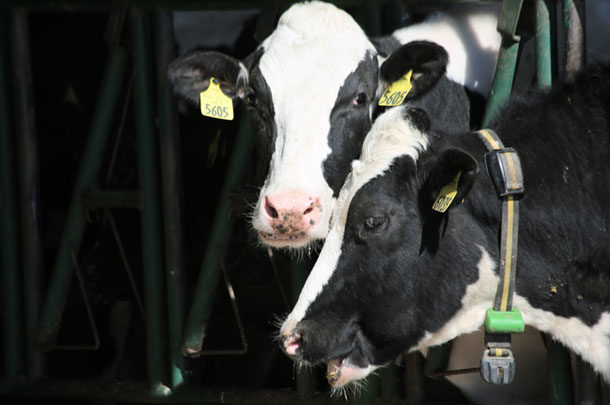“There is a revolution going on in activity systems,” said Kevin Havartine, Ph.D., assistant professor of nutritional physiology at Penn State University’s department of animal science.
As collar and ear tag monitoring devices provide real-time analytical data on rumination, another data point is added for dairy herd management.
“Cows will normally ruminate 10 to 11 hours a day depending on ration particle sizes and frequency of feeding,” Havartine said. “It goes back to their prey status, to eat quickly and then rest and chew at a leisurely pace in a place of relative safety from predators.”
He provided an inside look at rumination for the 35 dairy producers who braved the extreme cold on Feb. 17 to gather for the Penn State Technology Forum in the equipment shop at Burk-Lea Farms, Chambersburg, Pennsylvania.
“As the cow chews, she creates a larger surface area for microbes to attach to the fiber and break it down to get more energy,” he explained. “By slowing digestion with particle size, we see more rumination. The cow decides when it is digested small enough to enter the abomasum, leaving the bigger particle sizes in the rumen for more chewing.”

Measuring rumination is an indirect way to show if the rumen has fill and can indicate rumen pH. By looking at the number of chews along with chewing time, 24-hour monitoring can chart rumination via collars, ear tags and halters, and sync that information to various herd management software programs.
“What we want to see is a daily rhythm, a pattern of rumination, not just the frequency,” Havartine said. “If you feed twice a day, that pattern will look different than a farm feeding more often.”
When selecting activity and rumination monitoring technology, Havartine recommended a well-designed interface to access real-time data on mobile devices.
“You want to be able to get the data quickly to act on it. That is essential, but also challenging,” he said.
Rumination monitoring has a three-fold purpose. It helps the dairy manager monitor ration performance among the herd and things like the effect of heat stress. It indicates subclinical disease or the pre- and post-calving status of individuals, and the number-one use of the rumination data is to help determine estrus.

Not all cows are the same. Producers on the panel were quick to point out the learning curve with any technology and how the combination of multiple data points yields the most systematic results. In this case, using the rumination along with activity results in two data points yielding better information than reliance on activity alone.
For Clint Burkholder of Burk-Lea Farms, the activity and rumination data have become integrated into his herd management through Semex ai24. He said at this point, he is working away from the problem repro cows by identifying and culling them, and has improved the herd’s pregnancy rate by 10 percent. He runs the data from the SCR Dairy collars into DairyComp 305.
The crew from nearby Dream Farms – a 10,000-head heifer-raising operation near Shippensburg – said they are using the ai24 monitoring system to provide a service to their dairy farm customers. “It shortens the breeding window for our customers, so they can measure the benefit in having a fresher herd and fewer days on feed to pay for in the heifer-raising.”
Of course, that helps Dream Farms turn numbers over as well. Manager Lane Sollenberger noted that in pushing for 1,400-pound heifers freshening at 22 months of age, “you need a lot of tools, and this is one of them.”

At Dream Farms, it has taken the place of watching for heats three hours a day, tail paint, lutelayse and CIDRs. Today, with activity and rumination monitoring, they breed twice a day using a list generated from the data synced to DairyComp. “We have seen an 11 percent increase in our heat detection and 9 percent increase in pregnancy rate, and the average age at conception is reduced by 10 days,” he explained.
For Bill Lesher of Way-Har Farms, Bernville, the benefits of a monitoring system go beyond the economics. “The combination of this and doing the blood testing to confirm pregnancy have reduced our labor and given us more flexibility,” he said. “We cut our ovsynch in half, and that’s a big deal for us because we are a family doing everything (all the shots) in the parlor.”
“Now we watch the graph instead of relying on shots,” said Lesher, whose dairy business includes bottling milk and making ice cream for wholesale and operating a retail store. “We are busy people. I look at the cost of my time, and this is one more tool to help me make the best use of it.” PD
Sherry Bunting is a freelance writer based in East Earl, Pennsylvania.
PHOTOS
PHOTO 1: Burk-Lea Farms is home to a milking herd of 700 cows. The pregnancy rate has improved 10 points since the collars were put on for monitoring.
PHOTO 2: Dr. Kevin Havartine talks about the “activity monitoring technology revolution” at the Penn State Technology Forum in Chambersburg, Pennsylvania.
PHOTO 3: Soaking up some sun on an extremely cold day during a break in the program, the Technology Forum producer panel from left to right: Clint Burkholder of the host farm, Burk-Lea Dairy, Chambersburg, Pennsylvania; Lane Sollenberger, Joshua Rabar and Brian Musser of Dream Farms, Shippensburg, Pennsylvania; and Bill Lesher of Way-Har Farms, Bernville, Pennsylvania.
PHOTO 4: One of two activity and rumination monitoring antennae is pictured here, above the milking center and across from the breeding age heifers at Burk-Lea Farms. Photos by Sherry Bunting.






